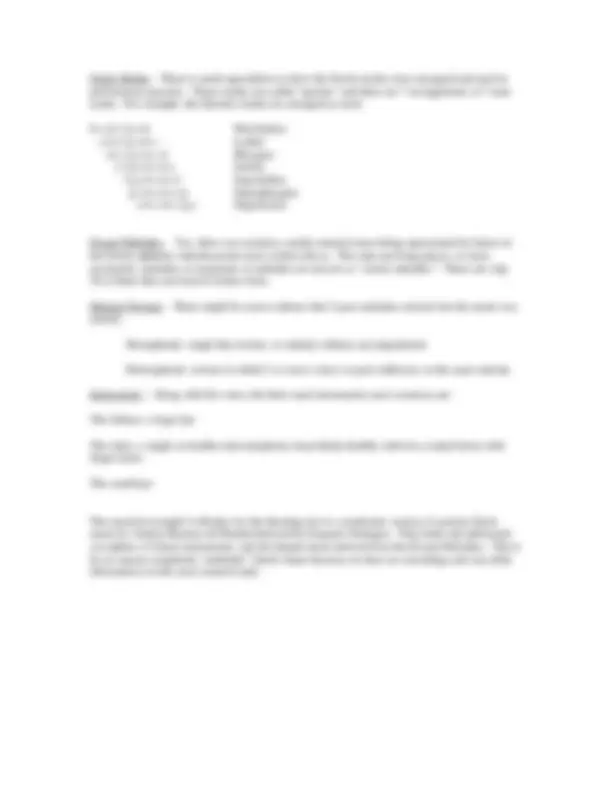



Study with the several resources on Docsity

Earn points by helping other students or get them with a premium plan


Prepare for your exams
Study with the several resources on Docsity

Earn points to download
Earn points by helping other students or get them with a premium plan
Community
Ask the community for help and clear up your study doubts
Discover the best universities in your country according to Docsity users
Free resources
Download our free guides on studying techniques, anxiety management strategies, and thesis advice from Docsity tutors
Explore the role of music in ancient greek life, its divine origin from gods and demi-gods, magic powers, and connection to mathematics and the cosmos. Discover greek musical theory, scales, and intervals derived from pythagoras and other philosophers. Understand the context of music in greek poetry, dramas, and instrumental contests.
Typology: Study notes
1 / 3

This page cannot be seen from the preview
Don't miss anything!


The Role of Music in Greek life - Music had divine origin from the gods and demi-gods: Apollo Amphion Orpheus Dionysus
Muses – the 9 daughters of Zeus, each presiding over an art form. The word “music” has been said to be derived from the word “muse.”
Music believed to have magic powers (ie. healing, purification of body and mind, and with miracles of nature).
Pythagoras found music and mathematics to be inseparable, with music also being common to activities concerned with the pursuit of truth and beauty.
Numbers were thought to be the key to understanding the spiritual and physical universe.
Music and the order of mathematics exemplified the harmony of the cosmos.
Musical materials (modes, intervals, notes) were associated with the various planets in early astronomy.
Plato discussed music and poetry with “the music of the spheres,” a concept that was influential to musical thinkers through later musical periods.
Ethos – moral qualities and affects of music rooted in the Pythagorean view of music as a microcosm; a system of sound and rhythm ruled by the same mathematical laws that operate in the whole of visible and invisible creation, and a force that affects the universe and the will and character of human beings.
Plato and Aristotle thought that a cultivated individual had to have the proper balance of knowledge and activities in music, philosophy, gymnastics and other sports, and mathematics.
Context – Music accompanied: poetic works (or “sung poetry”) and dance Greek dramas (“ritual theater”) derived from the Dionysus cult instrumental solo contests in festivals
With sung poetry, text and music were inseparable. Music was bound by the natural rhythm of syllables, poetic phrases, and voice inflection.
Sung poetry also associated with the Greek dramas (Tragedy/Comedy).
Instrumental solo contests involved improvisation (kept within accepted rules governing form and style suitable for particular occasions) and virtuosity.
Plato had considerable influence on musical propriety for specific occasions.
Greek Musical Theory
a) doctrines and nature of music and its place in the cosmos and human society b) systematic descriptions of materials and patterns of music
Pythagoras (6th^ Century B.C.E.) Archytas (ca. 380 B.C.E.) Aristoxenus (ca. 330 B.C.E.) Eratosthenes (ca. 230 B.C.E.) Didymos (30 B.C.E.) Ptolemy (140 C.E.)
Musical intervals and intonation (tuning) were derived from Pythagoras. Pythagoras derived scales by tuning successive perfect, or pure fifths and bringing the frequencies down within the same octave. He figured this out mathematically, and gave birth to what is called “Pythagorean Intonation.” Pythagorean intonation was further developed by the musical theorists/philosophers/mathematicians listed above, throughout the Greek period and into the Middle Ages and Renaissance periods.
Greek Musical Scales
Scales were derived from “tetrachords” (4-note descending adjacent intervals) called “genera.” These tetrachords all spanned the interval of a perfect Pythagorean 4th^ (4/3 or 498 cents). The intervals within the tetrachord were divided in different ways and classified into three different types:
Diatonic Genera– the tetrachord is generically divided into two Pythagorean whole tones and the small Pythagorean semi-tone descending from the top note: (204 – 204 – 90)
Chromatic Genera– the tetrachord is divided into one Pythagorean minor 3rd^ and the division of the Pythagorean whole tone, descending from the top note: (294 – 141 – 63) In this case, the second note of the scale is lowered by 90 cents (from the diatonic genera), creating the minor 3rd (294 cents) and the third note is lowered by 27 cents, dividing the whole tone (204 cents) by 2/ and 1/3 (141 cents, 63 cents). There are many versions of these divisions, this is just an example.
Enharmonic Genera – the tetrachord is divided into one Pythagorean major 3rd^ and the division of the small Pythagorean semi-tone, descending from the top note: (408 – 45 – 45) In this case, the second note of the scale is lowered by 204 cents (from the diatonic genera), creating the major 3rd (408 cents), and the third note is lowered by 159 cents, dividing the semi-tone (90 cents) in half (45 cents). There are many versions of these divisions, this is just an example.
These genera are put together to create 7-tone scales in two ways:
Conjunct – a 7-note scale consisting of two tetrachords, the end note of the first tetrachord coincides or is connected with the beginning note of the next tetrachord.
Disjunct – a 7-tone scale consisting of two terachords, divided by one Pythagorean whole tone (204 cents).